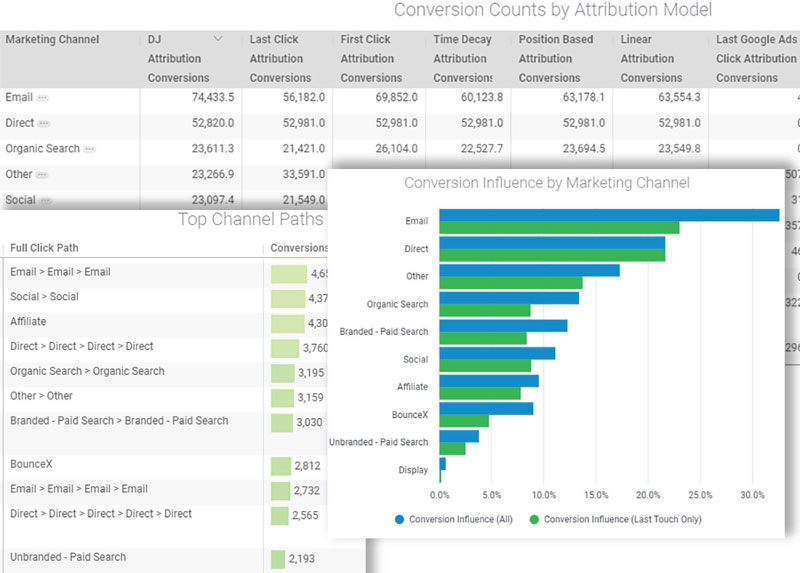Making Sense of Lead Attribution
August 18, 2020 •DJ Team

Which Lead Attribution Model to Use?
When choosing the best marketing attribution solution it can be hard to know where to start. After all, there are numerous attribution modeling tools available and you should select an approach that’s tailored to your business’ specific needs, patterns and functionality. Keep reading to learn more about tracking your company’s lead attribution to ultimately strengthen your sales strategies. It will also help you understand which of your marketing channels are working well -- and perhaps more importantly, which ones aren’t.
Because today’s marketing strategies and sales are often driven by multiple channels at once, making sense of lead attribution can seem like an impossible task. After all, how can you possibly determine which of your many marketing channels is producing tangible results and landing you the most business? The good news is that there are several different versions of attribution technology that can make your life easier. Check out the following attribution modeling tools that decode the complex web of your business’ marketing channels and sales.
Introducing: The Linear Attribution Model
Attribution tracking is a crucial step in measuring the effectiveness of your company’s current marketing channels. Not only can lead attribution models help you get a sense of what is producing results, they also reveal which of your various marketing strategies simply aren’t pulling their weight. In summary, utilizing an attribution model is an excellent way to “trim the fat” off of your professional marketing channels and make room for new creative approaches, growth and development. That being said, let’s dive into an example of an attribution model: the linear attribution model.
Particularly when dealing with B2B software marketing attribution, single-touch attribution models simply don’t cut it. You need to be able to track all of the different touchpoints that work together to bring the customer to the sale. Enter the linear attribution model, which is particularly useful for recognizing the different channels that play a role in making conversions/sales. The linear model assigns credit evenly among all of your business’ different marketing channels, which helps the client understand how each channel contributes to the final goal. The downside of the linear attribution model is that by highlighting the value of each marketing channel, it fails to show how some channels could be more influential than others in making conversions.
Navigating Marketing Attribution Software
Now that we’ve covered the linear attribution model, you hopefully have a better sense of the types of marketing attribution software that companies use to understand the effectiveness of their various channels. At the end of the day, marketing attribution tracking software is an indispensable tool for your business’ success -- that is, if you want to stay ahead of the game and keep improving your marketing strategies. There are numerous types of marketing attribution software that you can use to evaluate your marketing channels, including first touch, last touch, the position-based attribution model and more.

Regardless of the attribution model your company uses, it’s important to remember that there is no singular perfect attribution model. Trial and error is an inevitable part of getting your company’s marketing scheme right. With each new attribution model, it’s all about testing, measuring, adjusting and constantly evaluating how well certain models mold to your business. On top of that, you can use multiple attribution models within one business! Based on how consumers respond, the type of campaign you’re running or your particular marketing attribution strategy, you may find that multiple models make more sense than just one. The possibilities are truly endless when it comes to customizing an attribution model that helps your company achieve its goals.
Making Multi-Touch Attribution Work For You
In the modern marketplace, most sales are achieved through the efforts of several marketing channels, whether they be traditional advertising, a powerfully written blog or perhaps classic word of mouth. This marketing chain can be analyzed with the help of multi-touch attribution tools, which track and evaluate the effectiveness of each touchpoint on the journey to a sale.
In this way, companies can use tools like mobile attribution platforms -- which are entirely data-driven -- to analyze exactly how much a specific event, like a web browser advertisement, influences sales, sign-ups, engagement and more. While sales attribution may seem difficult to track and understand, attribution models and platforms can help your company accurately evaluate the influence of your marketing channels, putting you on the road to success.
At DemandJump, we created a platform that is built to improve cross-channel performance. DemandJump gives you access to multiple attribution models so you can utilize multiple in your decision making. The platform also provides automated recommendations on which actions you should take next to improve channel performance.
Featured Articles
Categories
- Attribution Tracking (13)
- Channel Optimization (11)
- Consumer Insights (68)
- Content Marketing (251)
- Data Science (8)
- Digital Marketing (6)
- Digital Transformation (26)
- Enterprise (10)
- Lead Generation (14)
- Market Intelligence (8)
- Marketing Analytics (39)
- Marketing Attribution (57)
- Marketing Management (153)
- Marketing Operations (86)
- Organic Search (222)
- Paid Search (52)
- Pillar-Based Marketing (63)
- Programmatic Advertising (9)
- SaaS Content (14)
- SaaS Marketing (29)
- Search Marketing (111)
- SEO Keyword Research (28)
- SEO Pillar (18)
- SEO Strategy (46)
- SMB (5)
- Website Content (12)

